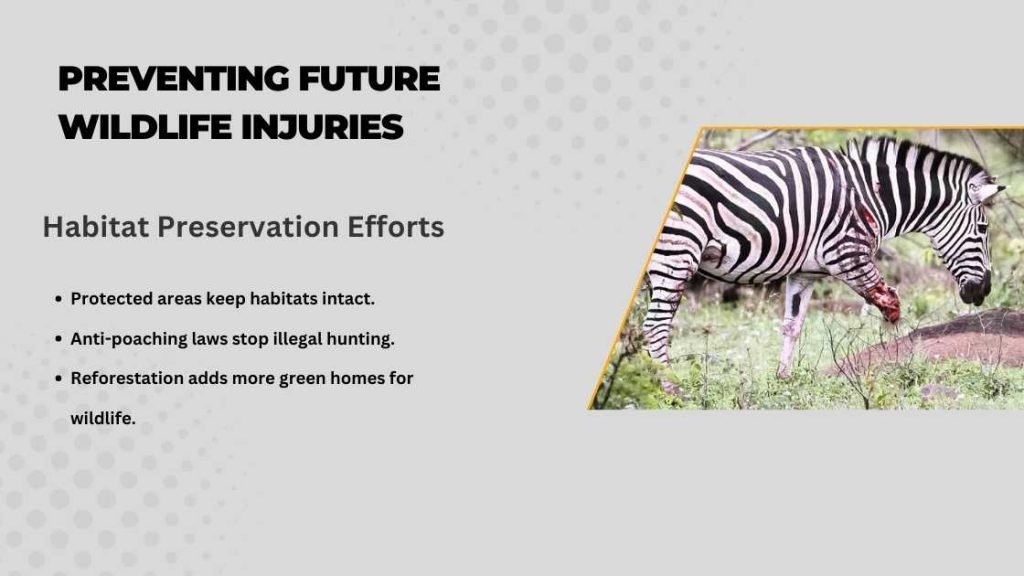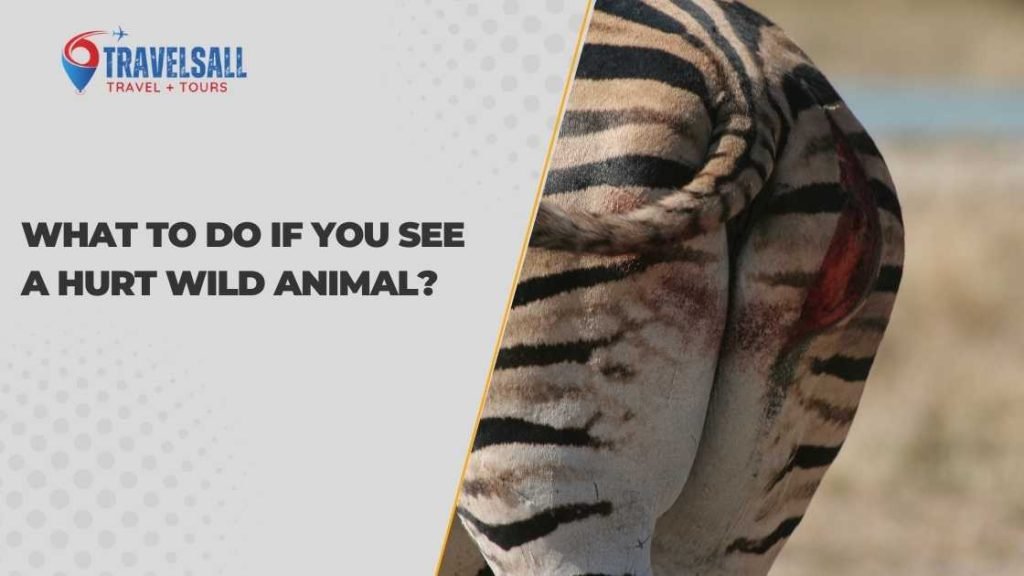If you see an animal that’s hurt in the wild, call the wildlife helpers right away. Stay far away to keep the animal calm and safe.
Seeing a hurt animal in the wild can be sad for anyone. If you want to help, be careful. Injured wild animals can act in unexpected ways and might be risky.
If you ever come across a wild animal that appears to be hurt or in distress, the most important thing to do is to inform adults who are knowledgeable about helping in such situations. What to Do If You See a Hurt Wild Animal? These special helpers have the expertise to administer the appropriate medicine and provide the necessary care until the animal recovers.
Seeking the right assistance not only ensures your safety but also increases the likelihood of the animal getting better. Remember to observe from a distance, as getting too close could potentially frighten the animal.
Table of Contents
ToggleInitial Response To An Injured Wild Animal

Encountering an injured wild animal can be startling. The initial steps you take are essential for the animal’s well-being. Your response should be swift yet thoughtful.
Safety First: Assessing The Situation
Keep yourself and others safe. An injured animal can be unpredictable. Here are key points:
- Keep a safe distance to avoid startling the animal further.
- Observe the animal’s condition without approaching too closely.
- Do not attempt to move the animal without professional help.
- Contact local wildlife authorities or a vet. Get expert advice.
Avoiding Further Stress on the Animal
Your actions can calm the situation or add stress. Follow these tips:
- Minimize noise and movements; stay calm and composed.
- Do not try to feed or water the animal. This could cause harm.
- Keep pets and children away to prevent extra stress or injury.
- Shield the animal from further dangers, such as traffic, if safe to do so.
Determining The Severity Of Injuries
Witnessing an injured wild animal can tug at the heartstrings. It’s vital to assess how badly the animal is hurt.
Quick thinking and the right actions can mean the difference between recovery and further harm. Careful observation is vital. Let’s learn to spot the signs of serious injuries.
Visible Wounds And Behaviors
Visible injuries are a clear call for help. Look for blood, broken bones, or wounds. If the animal is limping, it may have a fracture. Animals in pain might breathe fast or make noise. Physical signs like these need your utmost attention.
Subtle cues also matter. An animal sitting still, especially during the day, is not normal. Healthy wild animals avoid people. If they don’t, something is wrong.
- Blood or open wounds
- Limping or inability to move
- Labored breathing or vocal distress sounds
- Uncharacteristic stillness or lack of fear of humans
When To Intervene
Not all situations require you to step in. Assess if the animal is in immediate danger. Is it near traffic? Is there a predator close by? These scenarios warrant your intervention.
For your safety, contact a professional. Vets or local wildlife rehabilitators know how to handle injured wildlife. If the animal is large or potentially dangerous, keep a safe distance and call for help right away.
| Scenario | Action |
|---|---|
| Animal is bleeding | Contact wildlife rehabilitator |
| The animal is in a safe area | Monitor from a distance |
| The animal is in danger | Seek immediate expert help |
This section of the blog post provides a clear and simple guide on what you should look for when you encounter an injured wild animal and how to evaluate whether an intervention is necessary.
It includes instructions on how to interpret visible signs of distress and outlines the steps one should take in different scenarios—all formatted for clarity in HTML for a WordPress site.
Contacting Wildlife Professionals

Contacting Wildlife Professionals becomes essential when encountering a hurt wild animal. Immediate action ensures safety for both the animal and the public.
Expert help from local wildlife professionals is the best course of action. Here’s how to reach out to them effectively.
Identifying Local Wildlife Rescue Organizations
Begin by finding nearby wildlife rescue groups. Research on the internet or ask your community for recommendations. An equipped organization can provide the necessary help quickly. Make sure you have their contact details handy for emergencies.
Providing Essential Information
Your call to the rescue team should include vital info about the situation. Be ready to describe:
- The location of the animal—be as specific as possible.
- The species or a detailed description if you’re unsure.
- The injury was observed without getting too close or touching.
- Your contact information for follow-ups or additional help.
Remember, approach professionals immediately. Do not try to handle the wild animal yourself. This ensures the best care for the animal and keeps everyone safe.
Containment Strategies
Encountering a hurt wild animal can be distressing. Quick, careful action is essential. Proper containment strategies help ensure your safety and the animal’s well-being. Below are steps to safely capture and house injured wildlife until professional help arrives.
Safe Capture Techniques
Secure your safety first, then follow these guidelines:
- Wear gloves – Protect hands from bites and scratches.
- Approach calmly – Sudden movements can scare the animal.
- Use a towel or blanket – Gently cover the animal to reduce its stress.
- Prepare a container – A box with air holes makes a good temporary carrier.
Temporary Housing Considerations
Create a safe space for the animal while you wait for help. Remember these tips:
| Item | Description | Importance |
|---|---|---|
| Size appropriate container | Ensure it’s large enough for the animal to fit comfortably. | Essential |
| Quiet location | Keep the container in a space away from noise and people. | Critical |
| Minimal interaction | Avoid touching or talking to the animal to reduce stress. | Imperative |
Monitoring The Animal Pre-rescue

Stumbling upon an injured wild animal can tug at your heartstrings. Before jumping in to help, monitor the situation properly. This ensures the safety of both you and the animal. Here’s how to keep a watchful eye pre-rescue.
Observing From A Distance
Stay back and avoid startling the animal. Use binoculars to check for visible injuries. Note any signs of distress. Track the animal’s breathing and movements. Keep noise to a minimum. Alert others nearby to do the same.
Record the time and the animal’s condition. This information is vital for rescuers. Take note of the location. Remain hidden to prevent stressing the animal further.
Ensuring Animal Comfort
Minimize the animal’s discomfort without direct contact. Offer shade if the animal is in direct sunlight. Use a stick to gently move branches or leaves over the animal. Avoid feeding or offering water, as it might do more harm than good.
- Keep predators away by staying nearby.
- Remove any hazards in the vicinity quietly.
- Create a barrier with natural materials if it’s safe to do so.
Continuously observe changes in the animal’s condition. Contact a wildlife rescue organization with updates. Be patient, as help may take time to arrive. Ensure you have the correct contact details for the local wildlife authorities.
Legal Implications And Ethical Concerns
Encountering a hurt wild animal can stir deep emotions. You want to help, but it’s vital to consider laws and ethics first. The welfare of the animal and your safety are top concerns. Below, let’s explore the legal framework and respect for nature’s course.
Wildlife Laws
Protecting wildlife involves regulations. These laws ensure animal conservation and public safety. Before you act, know what’s legal. In many places, certain actions like handling wildlife may require permits or professional intervention. Find the specifics:
- Check with local wildlife authorities.
- Understand the protected species list.
- Learn the correct protocol for injured wildlife.
For example, transporting a wild animal without authorization might be illegal. Penalties can include fines or other serious consequences. Always contact professionals who are trained to handle wildlife.
Respecting Nature’s Course
Nature has its balance. Interfering can sometimes do more harm than good. Ethical concerns arise when thinking about intervention. Before stepping in, consider:
- Is the animal truly orphaned or injured?
- Would intervening disrupt natural processes?
- Can the situation be resolved without human help?
Animals often have better survival chances without interference. Remember, a professional’s guidance is crucial when in doubt. Opt for observation and contact experts with experience and understanding of wildlife behavior.
Preventing Future Wildlife Injuries

Seeing a hurt wild animal can tug at your heartstrings. What’s even better
is to create a world where wildlife injuries are rare. Let’s talk about how to safeguard our furry and feathered friends.
Habitat Preservation Efforts
Wild animals thrive in their natural homes. Preserving these spaces is key to keeping them safe. Here’s what’s being done:
- Protected areas keep habitats intact.
- Anti-poaching laws stop illegal hunting.
- Reforestation adds more green homes for wildlife.
We can help by supporting eco-friendly policies and groups.
Educating The Public
Knowledge is power, especially for wildlife protection. Here’s how education makes a difference:
- Teaching people about local wildlife.
- Sharing safe ways to watch animals.
- Explaining why we should not feed wild animals.
School programs and public campaigns are great tools.
Frequently Asked Questions On What To Do If You See A Hurt Wild Animal
What Will You Do If You See An Animal Hurt?
If you observe a hurt animal, approach cautiously. Contact a local animal rescue service or vet immediately. Keep the animal calm, and avoid touching unless necessary. Ensure your safety first. Await professional assistance.
What Should You Do If You See A Vicious Animal?
Stay calm and avoid making sudden movements. Don’t run; instead, slowly back away. Avoid direct eye contact with the animal. Seek shelter in a vehicle or building if possible. Report the encounter to local authorities immediately.
What Happens When Animals Get Injured In The Wild?
Animals in the wild with injuries must fend for themselves or rely on assistance from their group. Without human intervention, healing depends on the animal’s resilience and the severity of the injury. Survival often diminishes if the injury affects mobility or the ability to feed.
What To Do If You See An Animal In The Wild?
Keep a safe distance from the animal to avoid disturbing it. Remain quiet and avoid sudden movements. Do not attempt to feed or touch the wildlife. Keep pets on a leash to prevent conflict. Respect the animal’s habitat by staying on designated paths.
Conclusion
Encountering an injured wild animal can be distressing. Remember, your safety is paramount. Reach out to local wildlife authorities promptly. They are equipped to provide the necessary care. By taking the right steps, you ensure both the animal’s well-being and your own.
Let’s keep our wildlife safe.



